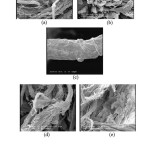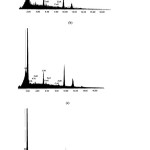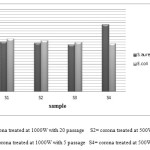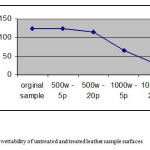Study effect coronadischarge on morphology, wettability and antibacterial of leather
L. Maleknia1*, G. Chizari Fard2 and F. Ekhlasi3
1Islamic Azad University, South Tehran Branch ,Department of Textile Engineering, Ahang Street, Nabard Blv,Tehran, Iran 2Department of Textile, Yazd Branch, Islamic Azad University, Yazd, Iran, 3Islamic Azad University, South Tehran Branch ,Department of Engineering and Technical, Ahang Street,NabardBlv,Tehran, Iran. Corresponding Author Email: Melika02@Azad.ac.ir
DOI : http://dx.doi.org/10.13005/ojc/31.Special-Issue1.32
Article Received on :
Article Accepted on :
Article Published : 09 Sep 2015
Corona discharge has been used widely to modify polymer and textile materials because it can be operated at an atmospheric pressure in air.This method has been confirmed to be simpler and more practical than any other chemical and physical methods because the samples can be quickly treated under atmosphere pressure and it is environmentally friendly too. In this study, we have studied wettability and antibacterial modify surface leather treatment by corona discharged. An element analysis was done to elucidate the change of chemical composition on the leather surface. The morphology of the modified surfaces also were investigated using scanning electron microscopy (SEM) .The results showed a significant increase in the wettability and antibacterial after treatment leather surface with corona discharge. Micrographs of SEM showed that, with an increase in power and a greater number of passages in the corona treatment, were increased cracks and hoes on the surface samples treated with corona.
KEYWORDS:Antibacterial ;Corona; leather;Morphology; wettability
Download this article as:| Copy the following to cite this article: Maleknia L, Fard G. C, Ekhlasi F. Study effect coronadischarge on morphology, wettability and antibacterial of leather. Orient J Chem 2015;31(Special Issue1). |
| Copy the following to cite this URL: Maleknia L, Fard G. C, Ekhlasi F. Study effect coronadischarge on morphology, wettability and antibacterial of leather. Orient J Chem 2015;31(Special Issue1). Available from: http://www.orientjchem.org/?p=10676 |
Introduction
Corona discharge has been proved to be a useful method for improving the polymer surface hydrophilic property, especially in the composite material strength improvement(Weilinet al.,2202; Strobelet al., 1999; Leeet al., 1992; Lanauzeet al., 1990; Ogawaet al., 2201)the treatment can improve the surface affinity and the sticking strength with some hydrophilic polymers , because the treatment can lead to the increasing of the high reactive free radical oxygen in polymer surface. Corona discharge was also applied in the chemical graft copolymerization (Bhallaet al., 1986; Nigamet al., 1986); this is also biased on that after the irradiation. New active group is produced and the monomer can be successfully grafted onto those active groups in the irradiated material. Some other researchers have introduced the corona discharge treatment into the textile surface treatment to improving the wool fabric printability (Ryuet al., 1991) or the wool fabrics shrink resistance properties (Bateupet al., 1981; Belinet al., 1983). Corona discharge technology is also increase wetability and soil repellency reduce the tendency to generate a static charge, increase fabric abrasion resistance and improvecarding spinability and cotton properties after mercerization and cause the depolarization of denim (Wakidaet al., 1993; Carneiroet al., 2000).The treatment has been confirmed to be simpler and more practical than any other chemical and physical methods because the samples can be quickly treated under atmosphere pressure. (Ogawaet al., 2001) The purposes of this research are firstly to investigatethe surface chemical composition of the untreated and corona treated leathers, secondly to study the influence of corona treatment on the antibacterial properties, thirdly to investigate wetability the treated and untreated corona leather.
Materials and Methods
Leather was provided by Charm Sazi Mojtahedi .Co (Tabriz Iran).The samples for further treatment were prepared in the size of 15.0cm*15.0cm.The samples were treated by corona discharge at two levels of power (500 and 1000w) for a number of passages each of 5 and 10 by corona discharge generator which was designed and constructed by Ghaemshahr Azad University (Iran). The equipment utilized had the following specification: velocity 2 m/min, distance between electrodes 3mm. the instrument consists of two electrodes: a metal electrode roll with silicon coating and an aluminum electrode parallel with it. The velocity of the roll was changeable and for this study was set at 2m/min.The antibacterial properties of samples leather were measured by ATCC-100 test method (antibacterial activity assessment of textile materials).The samples were placed on a germ-containing agar plate and were inoculated with gram positive staphylococcus aureus (ATCC 6538) and Escherichia coli (ATCC 8099).Specimens corresponding to untreated controls of the some material were placed in intimate contact with the nutrient agar, which previously had been streaked with inoculums of the test bacterium. After incubation for 24 h, we evaluated the antibacterial properties of both the untreated and the treated leathers.

A: the number of bacteria on the untreated leather
B: the number of bacteria on the treated leather after 24h.
The morphologies of the samples were observed with scanning electron microscope (SEM) and elemental analysis was conducted with EDAX spectra. The samples were coated with gold before SEM testing. The wettability measurements for all samples (treated and untreated leather) by using a micrometer pipette, while the first: liquid drops were dispersed on each leather samples, then we calculated the time adsorption of liquid drop with samples.
Results and Discussion
SEM Observation
Corona treatment influences the morphologies and Structures of leather greatly. The morphologic changes of leather after corona treatment can be seen clearly from SEM images. Fig1. Shows the morphology of original and corona treatment leathers.
 |
Figure 1: SEM micrograph of corona treatment leathers and original:(a)corona treated at 1000W with 20 passages;(b) corona treated at 500W with 20 passages; (c) corona treated at 1000W with 5 passages;(d) corona treated at 500W with 5 passages;(e) original Click here to View figure |
It is obvious that, with an increase in power and a greater number of passages in the corona treatment, were increased cracks and hoes on the surface samples treated with corona. This is attributed to the etching effect caused by the bombardment of the air plasma species on the leather samples surface.
The Microstructure Characterization
The characteristic peaks for different element in the functional layer are presented in EDAX spectra, which was obtain for the surface of samples, as shown in fig 2. It is important to note Ag, Fe and Zn appeared on the samples treated surface. Therefore it can be suggested that the antibacterial properties of samples treated with corona be related to appear this ion metal.
 |
Figure 2: EDAX spectra micrograph :(a)corona treated at 1000W with 20 passage;(b) corona treated at 500W with 20 Passage; (c) corona treated at 1000W with 5 passage ;(d) corona treated at 500W with 5 passage;(e) original Click here to View figure |
Antibacterial Property
Table I shows the antibacterial effect of corona treatment on leather samples. It can be seen that the antibacterial efficiency against E.coli and s. aureus was higher than 68% for samples treated with corona.
Table 1: Antibacterial effect of corona treatment on leather samples
|
Sample |
S.aureus |
E.coli |
|
S1 |
72.9 |
76.7 |
|
S2 |
71.2 |
74.9 |
|
S3 |
68.5 |
72.5 |
|
S4 |
67.9 |
70.4 |
 |
Figure 2B Click here to View figure |
Effect on wettability
The effect of corona treatment on wettability of leather samples was shown in Fig.3. The results indicate the corona treatment improved the hydrophilicity of leather and with increase of treated voltage; high energy leads to an obvious increase in wetting properties. It was mainly ascribed to the breakage of macromolecule bond resulting from the bombardment of high-energy particle.
These results could be related to the free polar component of the leather surface while these free radicals contacted with air and more hydrophilic constituents such as carboxyl groups formed in the leather surface, which increased the wetting properties of leather.
 |
Figure 3: wettability of untreated and treated leather sample surfaces Click here to View figure |
Conclusion
The leather surfaces can be modified to be more hydrophilic by corona discharge. Good hydrophilic property was observed around 1000w when the leather surface was treated at 10 passages by corona discharge. The leather surface treated with corona can be used as antibacterial treatment. The antibacterial efficiency against S-aureus and E-coli was higher than 70% for samples treated with corona. A rougher surface fabric is a good padding cloth and a rougher fabric surface is important in the conventional aqueous textile finishing and dying processing because of the higher rate of liquid uptake.
Refrences
- Weilin, X.u; Xin, L.i.u; Surface modification of polyester fabric by corona discharge irradiation European Polymer Journal, 2002., 39, PP.199-202.
- Strobel, J.M; Strobel, M; Lyons, C.S; Dunatov,CAging of air-corona-treated polypropylene film;J Adhes Sci Technol, 1991, 5, PP.119.
- Lee ,J.H; Kim, H.G; Khang, G.S; Lee, H.B; Jhon, M.S;J Colloid Interf Sci,. 1992., 151, 563.
- Lanauze, J.A; Myers, D.L; Ink adhesion on corona-treated polyethylene studied by chemical derivatization of surface functional groups J ApplPolymSci, 199, 40, PP.595.
- Ogawa, T; Mukai, H; Osawa, S;Improvement of the mechanical properties of an ultrahigh molecular weight polyethylene fiber/epoxy composite by corona-discharge treatment J Appl Polym Sci,. 2001., 79,.1162-1168.
- Bhalla, G.L; Nigam, J.K; Grafting Methyl-Methacrylate on DC-Corona and Chemically Pretreated Wool Fabric Textile Res J, 1986., 56., PP.585-586.
- Ryu, J.M; Wakida, T; Takagishi, T; Effect of Corona Discharge on the Surface of Wool and Its Application to PrintingTextile Res J, 1991., 61, .595-601.
- Bateup, B.O; Feldtman, H.D; J Textile Inst,.1981., 72, PP.34.
- Belin, R.E; Hayes, R.L;Mutsaerts, G; J Textile Inst,.1983., 74, PP.191.
- TomijiWakida, Seiji Tokino, ShouhuaNiu, Haruo Kawamura, Yukihiro Sato, Muncheul Lee, Hiroshi Uchiyama Hideo Inagaki;Surface Characteristics of Wool and Poly ( ethylene Terephthalate) Fabrics and Film Treated with Low-Temperature Plasma Under Atmospheric PressureText Res J,. 1993., 63, PP.433-438.
- Rouette, H .K; Encyclopedia of Textile Finishing(Germany: Springer),2001.,PP.429.
- Karmakar ,S. R, Chemical Technology in the Pre-treatment Processes of Textiles, Textile Science and Technology Series,1999., 12, PP.396.
- Thorsen ,W. J; Modification of the Cuticle and Primary Wall of Cotton by Corona Treatment Text Res J,(Jun).1974.,PP. 422-428.
- Carneiro, N ;Souto, A. P; Color Technol, 2001., 117, PP.298.
- Tomiji Wakida, Seiji Tokino, Shouhua Niu, Muncheul Lee, Hiroshi Uchiyama, Masami Kaneko; Dyeing Properties of Wool Treated with Low-Temperature Plasma Under Atmospheric Pressure; Text Res J, 1993., 63, PP438-442.
- Oktem, T ;Seventekin, N; Indian; J Fibre Text Res,.2002., 27, PP.161.
- Yip,J ; Chan, K; Sin, K .M ; Lau ,S. H. K, Color Technol,2002., 118, PP.26.
- Ozdogan, E; Saber, R; Ayhan, H ; Seventekin, N; Color Technol,2002., 118, PP.100.
- Carneiro, N; Souto, A .P ; Rios, M. J, Int Text Conf,Istanbu,Turkey.2005.,PP66.
- Rajpreet K. Virk, Gita N. Ramaswamy, Mohamed Bourham, Brian Lee Bures; Plasma and Antimicrobial Treatment of Nonwoven Fabrics for Surgical Gowns; Text Res J,. 2004., 74, 1073-1079.
- Temmerman, E ; Leys ,Ch;Surface modification of cotton yarn with a DC glow discharge in ambient air Surf Coat Technol , 2005., 200, 686.
- Ghoranneviss, M; Moazzenchi ,B ; Shahidi, S; Anvari ,A ; Rashidi, A;Decolorization of Denim Fabrics with Cold Plasmas in the Presence of Magnetic Fields Plasma Processes Polym, 2006., 3, PP.316.
- Ghoranneviss, M; Shahidi ,S; Moazzenchi ,B; Anvari, A; Rashidi,A ; Hosseini, H;Comparison between decolorization of denim fabrics with Oxygen and Argon glow discharge Surf Coat Techno, 2007, 201 ,PP4926.
- Dascalu ,T; Acosta-Ortiz, S .E; Ortiz-Morales, M ; Compean, I;Removal of the indigo color by laser beam–denim interaction Optics Lasers Eng,.2000, 34 , 179-189.
- Malek, R. M. A ;Holme, I; The Effect of Plasma Treatment on Some Properties of Cotton Iranian Polym J, 12 . 2003., 271.
- Carneiro, N; Souto, A. P; Marimba ,A; Marques, A. P; Leal, C; Burrows, H .D; Proc Fiber Soc, Meeting, Guimaraes, Portugal, 2000., 171.

This work is licensed under a Creative Commons Attribution 4.0 International License.









